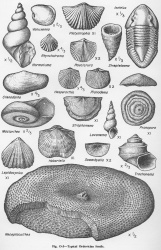St. James Member
Lithostratigraphy: Ottawa Limestone Megagroup >>Galena Group >>Kimmswick Subgroup >>Dunleith Formation >>St. James Member
Chronostratigraphy: Paleozoic Erathem >>Ordovician System >>Champlainian Series >>Trentonian Stage
Allostratigraphy: Tippecanoe Sequence
Primary source
Willman, H. B., Elwood Atherton, T. C. Buschbach, Charles Collinson, John C. Frye, M. E. Hopkins, Jerry A. Lineback, and Jack A. Simon, 1975, Handbook of Illinois Stratigraphy: Illinois State Geological Survey Bulletin 95, 261 p.
Contributing author(s)
H. B. Willman and T. C. Buschbach
Name
Original description
The St. James Member of the Dunleith Formation (Templeton and Willman, 1963, p. 119).
Derivation
Named for St. James Cemetery in Stephenson County, 3 miles northwest of the type section.
Other names
The St. James Member is called the "Gray" in the lead-zinc district.
History/background
Type section
Type location
The type section of the St. James Member is located in the same exposure as the Buckhorn type section (a quarry at Buena Vista (NW SW NE 15, 28N-7E)), where the St. James is 13.3 feet thick.
Type author(s)
Type status
Reference section
Reference location
Reference author(s)
Reference status
Stratigraphic relationships
The St. James Member of the Dunleith Formation overlies the Buckhorn Member.
Extent and thickness
The St. James Member commonly is about 14 feet thick in the dolomite facies in northern Illinois and 8-12 feet thick in the southern limestone facies.
Lithology
In northern Illinois the St. James Member is light tan, pure, medium-bedded, vuggy dolomite, but thin green shale partings are common in the upper 2-4 feet. It has black speckles but not as many as the Buckhorn. In the southern area the St. James is a coarse-grained, gray to brown, faintly gray-speckled calcarenite that locally has a few inches of conglomerate at the base.
Core(s)
Photograph(s)
Contacts
Well log characteristics
Fossils
Prasopora simulatrix (fig. O-5) is common in the upper few inches of the St. James Member in the extreme northwestern part of the state but has been found eastward only as far as Rockford, where it is rare.
Age and correlation
Environments of deposition
Economic importance
Remarks
References
TEMPLETON, J. S., and H. B. WILLMAN, 1963, Champlainian Series (Middle Ordovician) in Illinois: Illinois State Geological Survey Bulletin 89, 260 p.
ISGS Codes
| Stratigraphic Code | Geo Unit Designation |
|---|---|
